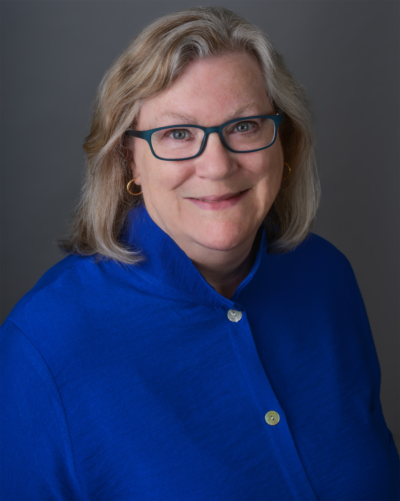![]()
![]()
 Episcopal Women’s History Project
Episcopal Women’s History Project
Award Ceremony September 9, 2022
The Rev. Gay Clark Jennings
Thank you very much for this invitation to join you today, and thank you so very much for the honor of receiving the, Every Woman Counts Award.
As requested, I am glad to share little bit about my story with some reflections on the leadership of women in our beloved church which is sometimes late to the party in terms of inclusion and counting everyone, but often works mightily to make up for a late arrival.
I was a young woman of 23 when I went to see the Bishop of Central New York to tell him I was going to seminary. It was August of 1974 and I had already been accepted at the Episcopal Divinity School in Cambridge, Massachusetts. I was going on my own self-devised trial year, but the rector of my parish said I should let the bishop know of my plans. So I met with Bishop Ned Cole, who looked like Methuselah, and I told him what I was doing.
I met with the bishop two weeks after the ordination of the Philadelphia 11, one of whom was resident in Central New York. Bishop Cole, although in favor of the ordination of women, was not amused.
He said, “Young lady, why exactly are you here? What do you want from me?”
I responded, “I came because my rector told me I had to come see you. And so here I am. And I don’t want anything from you. ” He replied, “You are the first person in a long time to come to see me who doesn’t want anything.”
He then looked at me over the bridge of his bifocals and asked me a question that I somehow knew was important to him. He asked, “Gay, what will you do if you aren’t ordained?”
I looked him square in the eye and said without hesitation, “Something else!” He burst out laughing and told me he hoped he would be the first to know if I decided I wanted to be ordained. I didn’t tell him that I was still a member of the Presbyterian Church; that seemed irrelevant since I had been attending the Episcopal Church off and on for a couple of years when I was home from college. But that’s another story.
I went off to Episcopal Divinity School in Cambridge, Massachusetts for seminary, and my trial year turned into three. While I was there, I met, at a poker game, the man who has now been my husband for nearly 45 years. Albert and I were married on August 14, 1976, just before our last year in seminary and a few weeks before the historic 65th General Convention.
After taking our honeymoon and moving into a new apartment in Cambridge, I made the first of many church governance-related requests to which my extraordinarily patient husband has agreed over the past four and a half decades. “Honey, could you set up the apartment while I go to Minneapolis to see what will happen?”
Because the 65th General Convention in 1976 made the canons governing ordination equally applicable to men and women, I have served the Church as an ordained person for more than forty years. The Church we all love did “something else” when it passed that canon. I have a confession. When I was ordained so long ago, I thought that was the big story – that women could be ordained. But I was wrong. Really wrong. The primary reason I could be ordained was because of the witness and persistence of lay women – but I did not fully appreciate that fact as a young, ordained woman. The history of the witness and persistence of lay women is rich as so many of you know, and I thank EWHP for keeping so much of the history alive.
In the forty-six years since that tense day in Minneapolis, the leadership of women, lay and ordained, has changed the church, the way we govern ourselves and the way we understand broader issues of inclusion. The movement for women’s leadership established networks, generated momentum and raised up leaders who pushed for the full inclusion of gay, lesbian, bisexual and transgender people in the life of the church, insisted that we deal with clergy sexual misconduct, and galvanized other movements for social justice.
The truth I have come to understand is that my story begins not with the struggle for women’s ordination, but with the struggle for women to take their rightful place in the governance of the church by serving in the House of Deputies. That movement began in 1913, and some think we didn’t get the job done until 1970 when women were seated as deputies. But, for one convention, in 1946, a woman named Elizabeth Huntington Dyer from the Diocese of Missouri was seated in the House of Deputies.
Her bishop, Bishop William Scarlett, put her up to it. She was the sister of a priest and the niece of a bishop, and the people who wanted to see women take their place in the councils of the church thought she’d be hard to turn away.
Betsy Dyer served at that convention, but by 1949, the opposition had organized. Four duly elected women—one each from the Dioceses of Nebraska, Olympia, Missouri and Puerto Rico—were denied seats in the House of Deputies, and the convention decided to handle the controversy in that most Anglican of ways—appointing a commission. Its formal name was the “Joint Commission to Consider the Problem of Giving the Women of the Church a Voice in the Legislation of the General Convention.” Its report is in the Journal of the 1952 General Convention, and I commend it to you, especially if you are a student of the many and varying ways the church can avoid committing justice.
You won’t be surprised to learn that the Joint Commission to Consider the Problem of Giving the Women of the Church a Voice in the Legislation of the General Convention did not solve the problem it was convened to address. In fact, every General Convention between 1943 and 1964 rejected resolutions to seat women.
In 1964, the bulwark that male deputies had constructed began to crumble. Some of you know the story of how it finally fell—the wrecking balls included grace, shame and money. Dr. Pamela Darling tells the story in her book, New Wine, and I relied on it when I wrote a chapter on this subject in “Looking Forward, Looking Backward,” a book of essays edited by Dr. Fredrica Harris Thompsett, a deputy, a laywoman, and longtime seminary professor, to mark the 40th anniversary of women’s ordination. It is a story full of lessons for the pursuit of equality in the church. Here is what Pam Darling says:
Time after time the women of the Triennial politely petitioned, and time after time the deputies refused—as each Convention duly performed the rituals of deference and power embedded in the United Thank Offering, modestly presented by the women and magnanimously received by the men. Power does not bow to deference, and it was not until a greater power was exerted, in the form of the increasingly embarrassing distance between secular and church practices highlighted by Presiding Bishop Lichtenberger’s sharp rebuke in 1964, that the men of the Convention finally voted to allow women to join them as deputies.
Lichtenberger, a beloved bishop who was retiring due to ill health, spoke in firm tones to a joint session of the 1964 General Convention, pointing out to the assembled men the contradiction inherent in their refusal to seat women in spite of their willingness to accept nearly $5 million from the United Thank Offering and to adopt a document titled “Mutual Responsibility and Interdependence” from the 1963 Anglican Congress.
“What we did this morning and what we do now is reality—the other is, I believe, the unwillingness to face the fact that women are members of the Body of Christ, that they are of the laity and members of the Body of Christ,” he said.
Later in the day, House of Deputies President Clifford Morehouse, a distinguished publisher and supporter of seating female deputies, called the house to order and directed that Presiding Bishop Lichtenberger’s statement be read again. Despite that appeal, the deputies were unhappy with the Presiding Bishop’s attempt to influence business in the House of Deputies and stood firm.1
At the next General Convention, in 1967, the deputies finally gave way.2 Here’s why: As the Episcopal Church Women’s financial power grew, so did women’s political clout. The United Thank Offering, which had totaled just over $44,000 in 1875, was up to $2 million by 1949 and in 1951, received a single donation of over $1 million in addition to smaller gifts and coins dropped into its ubiquitous blue boxes.3
At the 1967 General Convention, Lueta Bailey of the Diocese of Atlanta was presiding officer of the Triennial, and she found herself at the center of a storm. Presiding Bishop John Hines was promoting a $9 million “Special Program” that he said would allow the Episcopal Church to “take its place humbly and boldly alongside of, and in support of, the dispossessed and oppressed peoples of this country for the healing of our national life.”
Bailey had been introduced to the issue of seating women female deputies in 1955 at General Convention in Honolulu, when she was first a delegate to the women’s Triennial Meeting. “I heard my first debate about women being seated as deputies and walked out because I was so angry, I didn’t know what to do,” she told Dr. Mary Sudman Donovan, who was herself a pioneer of women’s history in the Episcopal Church, in an interview for the Archives of the Episcopal Church in 1983. She was, she said, “In the House of Deputies and could only stand on the outside, you know, looking in…”
With Bailey presiding in 1967, the Triennial Meeting voted to approve Hines’ request that they contribute $3 million to the Special Program. The vote took place before the General Convention considered the initiative, and the women’s commitment to provide a third of the necessary funding exerted tremendous influence on the debate. In short, the women, denied a role in the governance of the church, exerted their authority by influencing the budget and pushing the church to look beyond itself in ministry and mission.
You will not be surprised to learn that many of the men did not like this turn of events. They complained that the women and their money were exercising too much power. Mrs. Bailey remembered, “We were constantly—harassment is not a good word but you never walked anywhere that some man who was a deputy didn’t bring up the subject,” She responded firmly and practically by locking the doors of the Triennial meeting hall. “…Some were encouraged but others were not and that’s why we kept the doors locked,” she said. “Because I knew some of those prominent men and they could come in and influence us.”
Then came the vote on admitting women as deputies. First the House of Deputies and then the House of Bishops voted in favor of seating women as deputies. “As I walked down the aisle [in the House of Deputies] I’ll never forget the mass of men snapping pictures of me going down…it was a great day in the life of the church. And it was not Lueta Bailey, it was all the women walking down that aisle.” On that day, she became the first woman to address General Convention, speaking in both the House of Deputies and in the House of Bishops.
Consider the magnitude of that fact. The first General Convention was held in 1785, and for 182 years, only men participated in it. For nearly two centuries, General Convention, the highest temporal authority of the Episcopal Church, heard and considered only the voices of men. Talk about being late to the party!
During Mrs. Bailey’s speech in 1967, word arrived that the House of Bishops had concurred with passage of the constitutional amendment that would allow women to be seated. Amending the church’s Constitution takes two votes of General Convention, and so after that, the story picks up three years later, on October 12, 1970, at the General Convention in Houston. The Journal of the General Convention 1970 tells the parliamentary story:
The Secretary read Message No. 2 from the House of Bishops, “which informed this House that the bishops had concurred with Deputies’ Message No. 2, in adopting, in final action, the amendment of Section 4 of Article 1. of the Constitution, which, by substituting ‘lay person’ for ‘layman,’ removes all constitutional barriers to the seating of women as Deputies in the General Convention.”4
If anyone ever tells you that church governance is boring and pointless, you can tell them that in 1970, it was Message No. 2 concerning the amendment of Section 4, Article 1 of the Constitution that brought the walls tumbling down.
Twenty-one years after that, in 1991, Pamela Chinnis became the first woman elected as president of the House of Deputies, and in 2012, I became the first ordained woman elected to that post. In 2018, I presided over the first General Convention at which a majority of deputies were women. And now, 52 years after women were seated as deputies, the president is a 41-year-old Latina lay woman, and the vice president is an ordained Indigenous woman. I can’t wait to see how President Julia Ayala Harris and Vice President Rachel Taber-Hamilton exercise their leadership. Buckle up, Church!
Inspired by the New York Times’ “Overlooked” series of obituaries of forgotten women, I began looking into how we remember the women who broke the barrier and gave women the vote in the Episcopal Church. The House of Deputies Rules of Order call for a necrology, now referred to as a Memorial Roll, to be read and entered into the Journal at each General Convention to honor members of the House who have died. It appeared that most of the women seated in 1946 and 1970 were not included. I did a lot of research, and it was my honor to rectify this omission when a special Memorial Roll was read at the 80th General Convention in July. It was powerful to hear the names of 59 lay women who had not been memorialized. I am continuing the research and I plan to write about these overlooked women and the forgotten history they made. There are stories remaining to be told.
Women’s leadership has helped to break down other barriers. My friend Gary Hall, a seminary classmate who delayed his own ordination by a year, refusing to take orders when his female classmates could not, notes five ways in which women’s leadership has changed the church. I commend his essay to you—it is also included in “Looking Forward, Looking Backward,” but I want to note one of them in particular. Gary says that the leadership of women has meant that the church has recognized what he calls “the particularity of social location.” “I would argue,” he writes, “that the leadership of women clergy and laity has been the driving force in our church’s difference in all its aspects. Once men in church leadership had to recognize that their work could be done by others who did not identify as they did, they had to be open to the possibility that their own gender (and racial and sexual) identity was contingent and not absolute.”5
A few years ago, I told a group of seminarians who identify as female that if we envision our goal to be the equality of ordained women in the Episcopal Church, or if we measure our progress solely by the number of female bishops, we are failing to understand the magnitude of the work to which God has called us. Especially now, as we reckon with the crisis of racial justice in our country, we must understand that the promise of female leadership in the church will only be realized when we commit completely to dismantling racism, misogyny, homophobia, and all of the interlocking oppressions that are antithetical to gospel work.
I also told them to be wary of calls to respond to declining membership and a secular culture by circling the wagons, tightening up the hierarchy, and limiting the kinds of leadership we accept and the variety of voices we hear. The legacy of women in the House of Deputies has been to open the doors not only to women leaders, but also to people of color, to LGBTQ people, and to younger people called to lead in our beloved church.
Thank you for your witness and ministry. It makes a difference to tell the stories of the women who have shaped our identity and witness as the church.
Bibliography
- Pamela W. Darling, New Wine: The Story of Women Transforming Leadership and Power in the Episcopal Church, (Cambridge, MA: Cowley Publications, 1994), 90-91.
- Lueta Bailey, interview by Mary S. Donovan, August 23, 1983, The Archives of the Episcopal Church.
- Anne B. Fulk, “Triennial Yesterday…The Matrix Affirmed.” Triennial Today ca. 1991, courtesy of The Archives of the Episcopal Church.
- General Convention, Journal of the General Convention of…The Episcopal Church, Houston, 1970 (New York: General Convention, 1970), 127.
- Hall, Gary. “But We Thought We Were So Normative: A Male Perspective on Women, Authority, and the Church” in Fredrica Harris Thompsett, ed. “Looking Forward, Looking Backward: Forty Years of Women’s Ordination,” (New York: Morehouse Publishing, 2014), 145.

